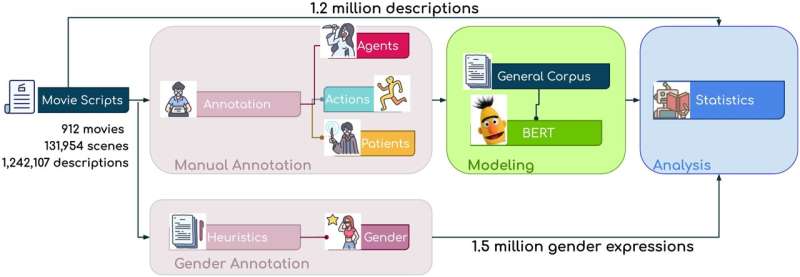Machine-learning framework finds characters’ actions in movie scripts reflect gender stereotypes

Researchers have developed a novel machine-learning framework that uses scene descriptions in movie scripts to automatically recognize different characters’ actions. Applying the framework to hundreds of movie scripts showed that these actions tend to reflect widespread gender stereotypes, some of which are found to be consistent across time. Victor Martinez and colleagues at the University of Southern California, U.S., present these findings in the open-access journal PLOS ONE on December 21.
Movies, TV shows, and other media consistently portray traditional gender stereotypes, some of which may be harmful. To deepen understanding of this issue, some researchers have explored the use of computational frameworks as an efficient and accurate way to analyze large amounts of character dialogue in scripts. However, some harmful stereotypes might be communicated not through what characters say, but through their actions.
To explore how characters’ actions might reflect stereotypes, Martinez and colleagues used a machine-learning approach to create a computational model that can automatically analyze scene descriptions in movie scripts and identify different characters’ actions. Using this model, the researchers analyzed over 1.2 million scene descriptions from 912 movie scripts produced from 1909 to 2013, identifying fifty thousand actions performed by twenty thousand characters.
Next, the researchers conducted statistical analyses to examine whether there were differences between the types of actions performed by characters of different genders. These analyses identified a number of differences that reflect known gender stereotypes.
For instance, they found that female characters tend to display less agency than male characters, and that female characters are more likely to show affection. Male characters are less likely to “sob” or “cry,” and female characters are more likely to be subjected to “gawking” or “watching” by other characters, highlighting an emphasis on female appearance.
While the researchers’ model is limited by the extent of its ability to fully capture nuanced societal context relating the script to each scene and the overall narrative, these findings align with prior research on gender stereotypes in popular media, and could help raise awareness of how media might perpetuate harmful stereotypes and thereby influence people’s real-life beliefs and actions.
In the future, the new machine-learning framework could be refined and applied to incorporate notions of intersectionality such as between gender, age, and race, to deepen understanding of this issue
The authors add, “Researchers have proposed using machine-learning methods to identify stereotypes in character dialogs in media, but these methods do not account for harmful stereotypes communicated through character actions. To address this issue, we developed a large-scale machine-learning framework that can identify character actions from movie script descriptions. By collecting 1.2 million scene descriptions from 912 movie scripts, we were able to study systematic gender differences in movie portrayals at a large scale.”
Boys don’t cry (or kiss or dance): A computational linguistic lens into gendered actions in film, PLoS ONE (2022). DOI: 10.1371/journal.pone.0278604
Citation:
Machine-learning framework finds characters’ actions in movie scripts reflect gender stereotypes (2022, December 21)
retrieved 21 December 2022
from https://techxplore.com/news/2022-12-machine-learning-framework-characters-actions-movie.html
This document is subject to copyright. Apart from any fair dealing for the purpose of private study or research, no
part may be reproduced without the written permission. The content is provided for information purposes only.
For all the latest Technology News Click Here
For the latest news and updates, follow us on Google News.

